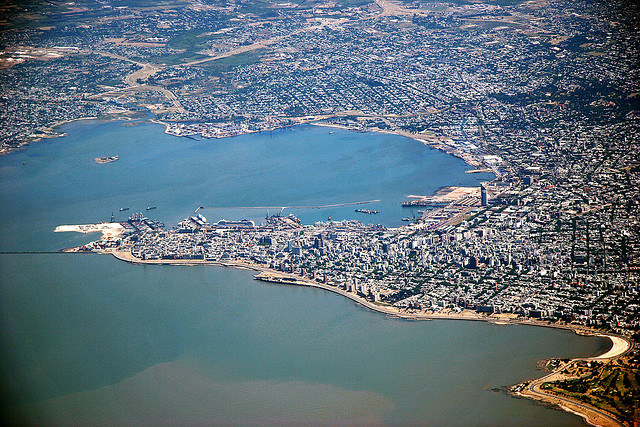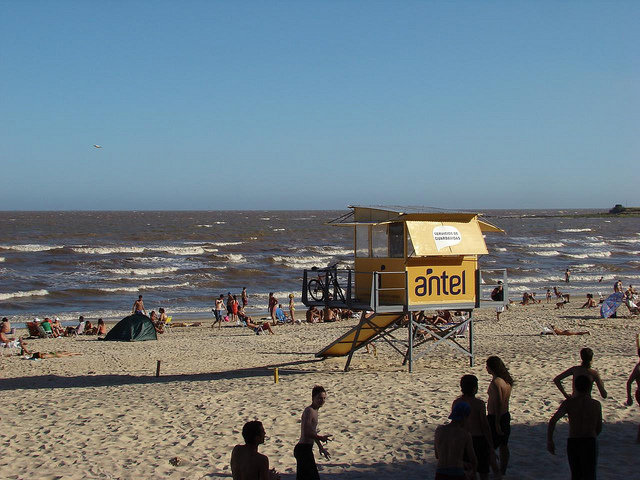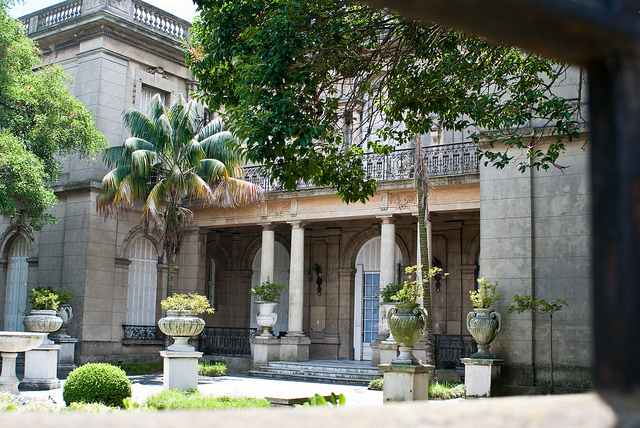Montevideo is a peculiar little place, more than happy to reward travellers who are willing to forsake a day or two in its big cousin Buenos Aires to explore the Uruguayan capital.

An aerial view of Montevideo, Uruguay. (Photo: M. Hintsa via Flickr)
We arrived at the Buquebus ferry terminal on a Saturday evening after an entirely worry-free glide across the water from Argentina, to be greeted by the chaos of a typical South American taxi queue. Eventually we were piloted to what seemed certain doom by a distant cousin of Fernando Alonso, careering along the coast road past drinkers, fishermen, Rambla ramblers and – oh thank you for being on the opposite carriageway – a Herbie-style Beetle parked in the fast lane.
We did however survive to reach our hotel in the barrio of Pocitos, the most frequently recommended area of Montevideo for tourists to stay. It’s easy to see why Pocitos is so often recommended; it’s a pleasant, peaceful suburban neighbourhood with a European feel, reminiscent of a small Mediterranean town.
From our well-equipped room at the Ermitage hotel on we set out to find food, having spied a nearby restaurant named La Otra. The walk of three blocks was easily navigated thanks to Montevideo’s grid system, and the resulting meal was magnificent. Unlike many chefs in Argentina, Uruguayans make a serious attempt to flavour their food, and a fine rib-eye steak was washed down with an enormous bottle of the local beer. The waiter regarded me wide-eyed and actually used the word ‘stupido’ when it became clear all the beer was for me, to which I put on my finest Englishman abroad nod-and-grin and set about drowning the memory of that frightening taxi.
La Otra is a classic parrilla – a style of South American grill – on a street named Tomas Diago in Pocitos. It forms one half of a pair of duelling parrillas, up against Tintos Y Rubias a block away on Pedro F Berro. As you can tell, here they like to name their streets after famous former residents of Montevideo.
We couldn’t not give Tintos Y Rubias a go on our second night. It had a fiery open grill that was enjogreat to watch while washing down another fine steak with a drop of Syrah, a lesser-known variety of red wine that works quite perfectly on this continent. But a competition needs a winner, and between our two parrillas La Otra came out on top, if only just.
Pocitos also includes the ‘seafront’, in fact a bank of the Rio de la Plata (the Atlantic is generally considered to begin further out to the east). Overlooking the river are some of the most impressive, or at any rate plush, buildings in Montevideo, which form a stark contrast with many of the older real estate you’ll find across most of the rest of the city. The beach at Pocitos is meant to be a glorious hive of life throughout the warmer months.

Pocitos Beach. (Photo: Pablo Flores via Flickr)
Easter reflection in Montevideo
Despite the 20 metre-high cross we found at the junction of three main streets in the Tres Cruses district, Easter Sunday was more a time for reflection in Montevideo, rather than a raucous celebration of Christianity as in other parts of South America. As we ambled around the city it became clear that this lapsed nation – left-wing government, legalised same-sex marriage, legalised abortion, legalised cannabis – use Easter Sunday as an excuse to have a well-earned break from the weekly hustle and bustle of the city.
Pavements carried just a few pedestrians, and cars appeared but sporadically. The lovely green space of Parque Batlle, nicknamed ‘the lungs of Montevideo’ (and roughly pronounced bah-shay) was slightly marred by the mess left over from the previous night’s Paul McCartney concert in the nearby national, but few would begrudge the city’s army of cleaners a day off in this laid-back Latin capital.
The stadium itself is an important monument in the story of football having held the first ever World Cup final, won by the hosts themselves in 1930, and its fairly ramshackle nature fitted in with the architecture we found elsewhere. Away from Pocitos, great portions of the city are quite bedraggled, with new developments fitting in beside the slow decaying colonial strongholds Montevideo is based upon. A brand new house will sit between two entirely differently designed, coloured but run-down buildings, somehow ageing the newer block as well. It’s a very characterful city in that regard, and though some may argue it could do with a lick of paint it’s hard not to imagine that may detract from the way past and present cohabit pleasantly here.
The main district of Montevideo that tourists make a beeline for is Ciudad Vieja, the old town. With its narrow streets and buildings even more weathered than elsewhere, it’s the most South American-feeling part of either this city or the Argentine capital. You can see deep into Montevideo’s past in the upper facades of each building, though at street level the old town has been populated by fast food joints and clothes shops – quite surprising given Ciudad Vieja is immediately to the west of Avenida 18 de Julio, the city’s principal shopping boulevard.
There are a number of pleasant squares to relax and watch the occasional Uruguayan pass by along Avenida 18 de Julio and into the old town. These include Plaza de Cagancha, Plaza Zabala and Plaza Constitucion, complete with finely decorated fountain, beautiful with autumn leaves falling from the trees.

Plaza Zabala. (Photo: A. Welch via Flickr)
The largest square is the Plaza Independencia, containing the impressive mausoleum of José Gervasio Artigas, ‘the father of Uruguayan nationhood’ who played a vital role in the creation of Uruguay as an independent country in the 1820s. Here you will also find the beautiful Teatro Solis, Uruguay’s oldest theatre, and the Palacio Estévez and Torre Ejecutiva government buildings.
Staying safe in Montevideo
With political power in our minds following our stroll around Plaza Independencia we decided to head up towards the Uruguayan Parliament building. Having missed our intended turn-off we figured it couldn’t hurt to cut through a couple of backs streets, given Uruguay is regularly named as one of the safest countries in Latin America. But on a day with fewer pedestrians around than usual, it can make you a little ill-at-ease to walk around an unfamiliar city far from home, off the main drag.
At one point we peered down a road to the right and thought ‘No way would we walk down there’ before turning the corner onto a road that was even more unwelcoming. As with any big city it’s wise to use common sense, and we immediately turned back to take the long way round.
Finally we made it to the Parliament building, to the north in the barrio of Aguada. And what a beauty it is, a truly epic example of a seat of government – a huge, grand building sitting proudly alone and uncluttered by other buildings nearby. It arguably belongs in a larger city like Buenos Aires, where the equivalent is limp by comparison. Take this building and the many statues and monuments scattered about Montevideo and you have the makings of a first-class city, fully deserving of the praise of its many fans.
Many buildings and most shops were closed on Sunday as expected, though one that was certainly open for business was the Cathedral, on the edge of Plaza Constitucion. From the outside Uruguay’s Catholic headquarters are architecturally unspectacular, but its interior is filled with icons of Uruguayan religious history, dating back to the building’s foundation by Spanish colonialists in the mid-18th century.
Talking of things closed at weekends, a note for anyone not familiar with the way banking works in a country like Uruguay. If you’re looking around for an ATM on the street, as you’d find in an average European or North American city, you won’t find any. The ATMs live indoors, often behind a door you’ll need the relevant bank card to enter, but there are ATMs open even on days like Easter Sunday, if you can find them. If in doubt, ask in the extremely helpful tourist information office at the corner of 18 de Julio and Ejido.
Biking and booming at Plaza de Cagancha
Not all Montevideo’s residents spent the day with their feet up – some feet were going round and round. At Plaza de Cagancha we found a couple of hundred people crowded around a handful of men in lycra, which turned out to involve the 100th anniversary of the Uruguayan Cycling Federation. This celebration included an exceptional set of drummers, edging very slowly down the street to an insistent beat as loudhailers boomed out indecipherable shouts from those running the event.
Crowds in unfamiliar places can be intimidating, but this crowd of Uruguayans was utterly non-threatening. Any sense of danger can be, and often is, a figment of the imagination in a city like Montevideo, though it’s important to note almost all articles on the city recommend tourists stay clear of the area around the port, just north of the old town (though the Buquebus port itself is fine).
One interesting quirk of Uruguayan life spotted either side of Plaza de Cagancha is that the people here are apparently obsessed with football stickers. Little tables are set up at spots along Avenida 18 de Julio with large boxes of stickers for the 2014 World Cup in Brazil. Queues of people formed to trade their swaps and fill gaps in their books, like so many schoolboys across the world. And there were men, women and children in these queues. ‘Soy celeste, soy celeste. Celeste soy yo’, as they will no doubt be singing this summer in support of their boys in sky blue.
Spending just one full day in Montevideo is enough to see the city, if not to experience it properly, and a trip to the region should be weighted more heavily in favour of Buenos Aires. It is certainly worth seeing, however, with its pretty squares and crumbling but characterful facades, and relaxed Uruguayans more than happy to welcome the unnecessarily wary traveller to their appealing city.